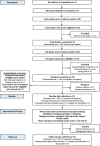A multi-component intervention to sit less and move more in a contact centre setting: a feasibility study
- PMID: 30866872
- PMCID: PMC6416901
- DOI: 10.1186/s12889-019-6615-6
A multi-component intervention to sit less and move more in a contact centre setting: a feasibility study
Abstract
Background: Call agents spend ~ 90% of their working day seated, which may negatively impact health, productivity, and wellbeing. This study aimed to explore the acceptability and feasibility of a multi-component workplace intervention targeting increased activity and decreased prolonged sitting in the contact centre setting prior to a full-scale effectiveness trial.
Methods: An 8-week non-randomised pre-post feasibility study was conducted. Using a mixed methods approach, focus groups and interviews were thematically analysed to explore the acceptability and feasibility of key study phases, and provide context to agents' process evaluation and survey responses. The multi-component intervention, conducted in a single call centre, included height-adjustable workstations, emails, education and training sessions, and support from team leaders and a workplace champion.
Results: Six (of 20) team leaders were recruited, with 17 of 84 call agents (78% female, 39.3 ± 11.9 years) completing baseline assessments and 13 completing follow-up. High workload influenced recruitment. Call agents perceived assessments as acceptable, though strategies are needed to enhance fidelity. Education sessions, height-adjustable workstations and emails were perceived as the most effective components; however, height-adjustable hot-desks were not perceived as feasible in this setting.
Conclusions: This study has identified unique, pragmatic considerations for conducting a multi-level, multi-component PA and SB intervention and associated evaluation in highly sedentary call agents in the challenging contact centre setting. The intervention was largely perceived positively, with call agents and team leaders describing numerous perceived positive effects on behavioural, health and work-related outcomes. Findings will be of value to researchers attempting to intervene in contact centres and will be used by the current authors to design a subsequent trial.
Keywords: Feasibility; Intervention; Physical activity; Sedentary behaviour; Standing; Workplace.
Conflict of interest statement
Ethics approval and consent to participate
Liverpool John Moores University (17/SPS/003) granted ethical approval and participants provided written informed consent.
Consent for publication
Not applicable.
Competing interests
The authors declare that they have no competing interests.
Publisher’s Note
Springer Nature remains neutral with regard to jurisdictional claims in published maps and institutional affiliations.
Figures
Similar articles
-
Multi-Stakeholder Perspectives of Factors That Influence Contact Centre Call Agents' Workplace Physical Activity and Sedentary Behaviour.Int J Environ Res Public Health. 2018 Jul 13;15(7):1484. doi: 10.3390/ijerph15071484. Int J Environ Res Public Health. 2018. PMID: 30011821 Free PMC article.
-
Reducing sitting at work: process evaluation of the SMArT Work (Stand More At Work) intervention.Trials. 2020 May 13;21(1):403. doi: 10.1186/s13063-020-04300-7. Trials. 2020. PMID: 32404181 Free PMC article.
-
Reducing occupational sitting: Workers' perspectives on participation in a multi-component intervention.Int J Behav Nutr Phys Act. 2017 May 30;14(1):73. doi: 10.1186/s12966-017-0530-y. Int J Behav Nutr Phys Act. 2017. PMID: 28558781 Free PMC article.
-
Workplace interventions for reducing sitting at work.Cochrane Database Syst Rev. 2018 Dec 17;12(12):CD010912. doi: 10.1002/14651858.CD010912.pub5. Cochrane Database Syst Rev. 2018. PMID: 30556590 Free PMC article.
-
Perceptions of the acceptability and feasibility of reducing occupational sitting: review and thematic synthesis.Int J Behav Nutr Phys Act. 2018 Sep 18;15(1):90. doi: 10.1186/s12966-018-0718-9. Int J Behav Nutr Phys Act. 2018. PMID: 30227861 Free PMC article. Review.
Cited by
-
Effectiveness of workplace interventions with digital elements to reduce sedentary behaviours in office employees: a systematic review and meta-analysis.Int J Behav Nutr Phys Act. 2024 Apr 19;21(1):41. doi: 10.1186/s12966-024-01595-6. Int J Behav Nutr Phys Act. 2024. PMID: 38641816 Free PMC article.
-
Rise and Recharge: Exploring Employee Perceptions of and Contextual Factors Influencing an Individual-Level E-Health Smartphone Intervention to Reduce Office Workers' Sedentary Time at Work.Int J Environ Res Public Health. 2021 Sep 13;18(18):9627. doi: 10.3390/ijerph18189627. Int J Environ Res Public Health. 2021. PMID: 34574551 Free PMC article.
-
Consolidated guidance for behavioral intervention pilot and feasibility studies.Pilot Feasibility Stud. 2024 Apr 6;10(1):57. doi: 10.1186/s40814-024-01485-5. Pilot Feasibility Stud. 2024. PMID: 38582840 Free PMC article.
-
Sedentary patterns and health outcomes in the oldest-old: a latent profile analysis.PeerJ. 2024 Jun 24;12:e17505. doi: 10.7717/peerj.17505. eCollection 2024. PeerJ. 2024. PMID: 38938606 Free PMC article.
-
Design, rationale and analysis plan for the Stand Up for Health trial in contact centres: a stepped wedge feasibility study.Pilot Feasibility Stud. 2020 Sep 23;6:139. doi: 10.1186/s40814-020-00683-1. eCollection 2020. Pilot Feasibility Stud. 2020. PMID: 32983556 Free PMC article.
References
-
- Wilmot EG, Edwardson CL, Achana FA, Davies MJ, Gorely T, Gray LJ, et al. Sedentary time in adults and the association with diabetes, cardiovascular disease and death: systematic review and meta-analysis: Springer; 2012. - PubMed
-
- Biswas A, Oh PI, Faulkner GE, Bajaj RR, Silver MA, Mitchell MS, et al. Sedentary time and its association with risk for disease incidence, mortality, and hospitalization in adults: a systematic review and meta-analysis. Ann Intern Med. 2015;162(2):123–132. - PubMed
-
- Department of Health DoH, Physical Activity, Health Improvement and Protection. Start Active Stay Active: A report on physical activity for health from the four home countries’ Chief Medical Officers. London, England: Department of Health 2011.
-
- Black CM. Working for a healthier tomorrow: dame Carol Black's review of the health of Britain's working age population: the stationery office. 2008.
Publication types
MeSH terms
Grants and funding
LinkOut - more resources
Full Text Sources
Medical
Miscellaneous


